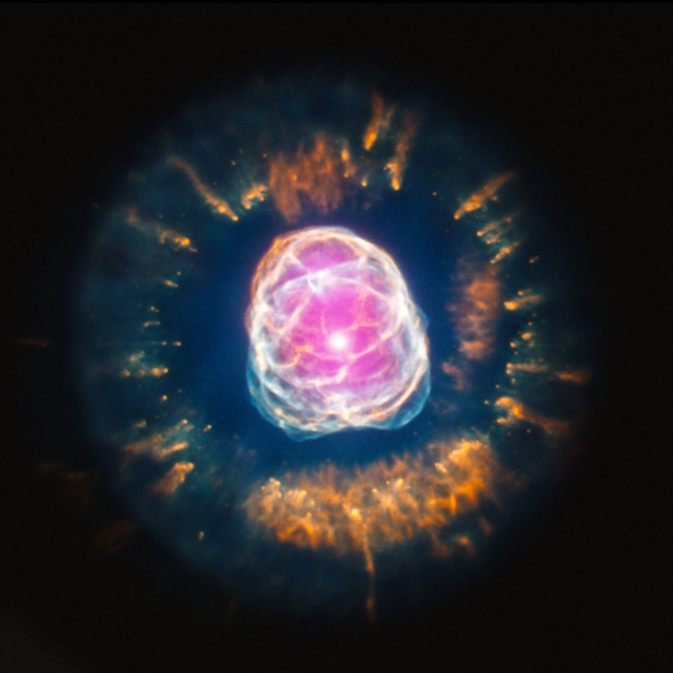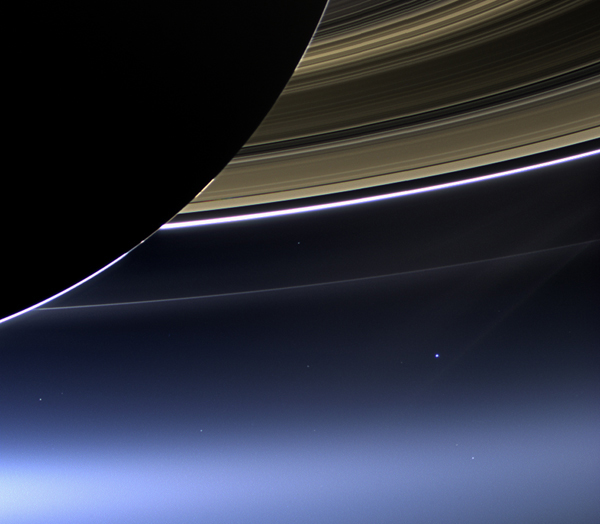Here are some beautiful space photos and videos that have been posted on the Internet recently. Enjoy!
This is onboard video of our latest mission, The Centennial Flight, that carried your star name into space June 21, 2013 from Spaceport America, New Mexico. It shows what it would be like to be on board the rocket, looking down as the rocket flies into space. Toward the end of the video you’ll see a note indicating “Apogee … 119 km.” That’s the point where the spacecraft reaches its maximum altitude (about 74 miles).

Stars like the Sun can become remarkably photogenic at the end of their life. A good example is NGC 2392, which is located about 4,200 light years from Earth. NGC 2392, nicknamed the “Eskimo Nebula,” is what astronomers call a planetary nebula. This designation, however, is deceiving because planetary nebulas actually have nothing to do with planets. The term is simply a historic relic since these objects looked like planetary disks to astronomers in earlier times looking through small optical telescopes.
Instead, planetary nebulas form when a star uses up all of the hydrogen in its core — an event our Sun will go through in about five billion years. When this happens, the star begins to cool and expand, increasing its radius by tens to hundreds of times its original size. Eventually, the outer layers of the star are carried away by a thick 50,000 kilometer per hour wind, leaving behind a hot core. This hot core has a surface temperature of about 50,000 degrees Celsius, and is ejecting its outer layers in a much faster wind traveling six million kilometers per hour. The radiation from the hot star and the interaction of its fast wind with the slower wind creates the complex and filamentary shell of a planetary nebula. Eventually the remnant star will collapse to form a white dwarf star.
Now days, astronomers using space-based telescopes are able to observe planetary nebulas such as NGC 2392 in ways their scientific ancestors probably could never imagine. This composite image of NGC 2392 contains X-ray data from NASA’s Chandra X-ray Observatory in purple showing the location of million-degree gas near the center of the planetary nebula. Data from the Hubble Space Telescope show – colored red, green, and blue – the intricate pattern of the outer layers of the star that have been ejected. The comet-shaped filaments form when the faster wind and radiation from the central star interact with cooler shells of dust and gas that were already ejected by the star.
The observations of NGC 2392 were part of a study of three planetary nebulas with hot gas in their center. The Chandra data show that NGC 2392 has unusually high levels of X-ray emission compared to the other two. This leads researchers to deduce that there is an unseen companion to the hot central star in NGC 2392. The interaction between a pair of binary stars could explain the elevated X-ray emission found there. Meanwhile, the fainter X-ray emission observed in the two other planetary nebulas in the sample – IC 418 and NGC 6826 – is likely produced by shock fronts (like sonic booms) in the wind from the central star. A composite image of NGC 6826 was included in a gallery of planetary nebulas released in 2012. [http://chandra.harvard.edu/photo/2012/pne/]
A paper describing these results is available online and was published in the April 10th, 2013 issue of The Astrophysical Journal. The first author is Nieves Ruiz of the Instituto de Astrofísica de Andalucía (IAA-CSIC) in Granada, Spain, and the other authors are You-Hua Chu, and Robert Gruendl from the University of Illinois, Urbana; Martín Guerrero from the Instituto de Astrofísica de Andalucía (IAA-CSIC) in Granada, Spain, and Ralf Jacob, Detlef Schönberner and Matthias Steffen from the Leibniz-Institut Für Astrophysik in Potsdam (AIP), Germany.
NASA’s Marshall Space Flight Center in Huntsville, Ala., manages the Chandra program for NASA’s Science Mission Directorate in Washington. The Smithsonian Astrophysical Observatory controls Chandra‘s science and flight operations from Cambridge, Mass.

In this rare image taken on July 19, 2013, the wide-angle camera on NASA’s Cassini spacecraft has captured Saturn’s rings and our planet Earth and its moon in the same frame. It is only one footprint in a mosaic of 33 footprints covering the entire Saturn ring system (including Saturn itself). At each footprint, images were taken in different spectral filters for a total of 323 images: some were taken for scientific purposes and some to produce a natural color mosaic. This is the only wide-angle footprint that has the Earth-moon system in it.
The dark side of Saturn, its bright limb, the main rings, the F ring, and the G and E rings are clearly seen; the limb of Saturn and the F ring are overexposed. The “breaks” in the brightness of Saturn’s limb are due to the shadows of the rings on the globe of Saturn, preventing sunlight from shining through the atmosphere in those regions. The E and G rings have been brightened for better visibility.
Earth, which is 898 million miles (1.44 billion kilometers) away in this image, appears as a blue dot at center right; the moon can be seen as a fainter protrusion off its right side. An arrow indicates their location in the annotated version. (The two are clearly seen as separate objects in the accompanying composite image PIA14949.) The other bright dots nearby are stars.
This is only the third time ever that Earth has been imaged from the outer solar system. The acquisition of this image, along with the accompanying composite narrow- and wide-angle image of Earth and the moon and the full mosaic from which both are taken, marked the first time that inhabitants of Earth knew in advance that their planet was being imaged. That opportunity allowed people around the world to join together in social events to celebrate the occasion.
This view looks toward the unilluminated side of the rings from about 20 degrees below the ring plane.
Images taken using red, green and blue spectral filters were combined to create this natural color view. The images were obtained with the Cassini spacecraft wide-angle camera on July 19, 2013 at a distance of approximately 753,000 miles (1.212 million kilometers) from Saturn, and approximately 898.414 million miles (1.445858 billion kilometers) from Earth. Image scale on Saturn is 43 miles (69 kilometers) per pixel; image scale on the Earth is 53,820 miles (86,620 kilometers) per pixel. The illuminated areas of neither Earth nor the Moon are resolved here. Consequently, the size of each “dot” is the same size that a point of light of comparable brightness would have in the wide-angle camera.
The Cassini-Huygens mission is a cooperative project of NASA, the European Space Agency and the Italian Space Agency. The Jet Propulsion Laboratory, a division of the California Institute of Technology in Pasadena, manages the mission for NASA’s Science Mission Directorate, Washington, D.C. The Cassini orbiter and its two onboard cameras were designed, developed and assembled at JPL. The imaging operations center is based at the Space Science Institute in Boulder, Colo.
For more information about the Cassini-Huygens mission visit http://www.nasa.gov/cassini and http://saturn.jpl.nasa.gov.

Credit: NASA/JPL-Caltech
As NASA’s Cassini spacecraft turned its imaging cameras to Earth, scientists, engineers and visitors at NASA’s Jet Propulsion Laboratory, Pasadena, Calif., gathered to wave at our robotic photographer in the Saturn system on July 19, 2013. This was part of a global, public participation effort organized by NASA called “Wave At Saturn.”